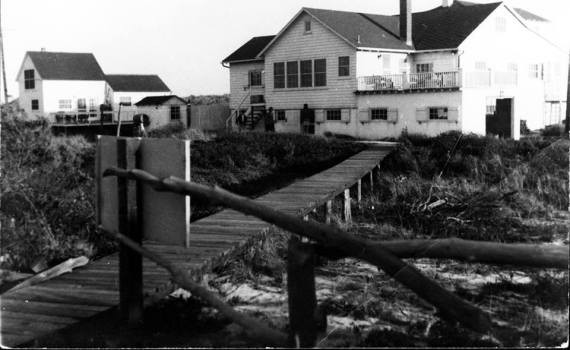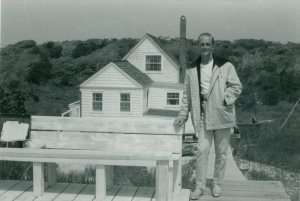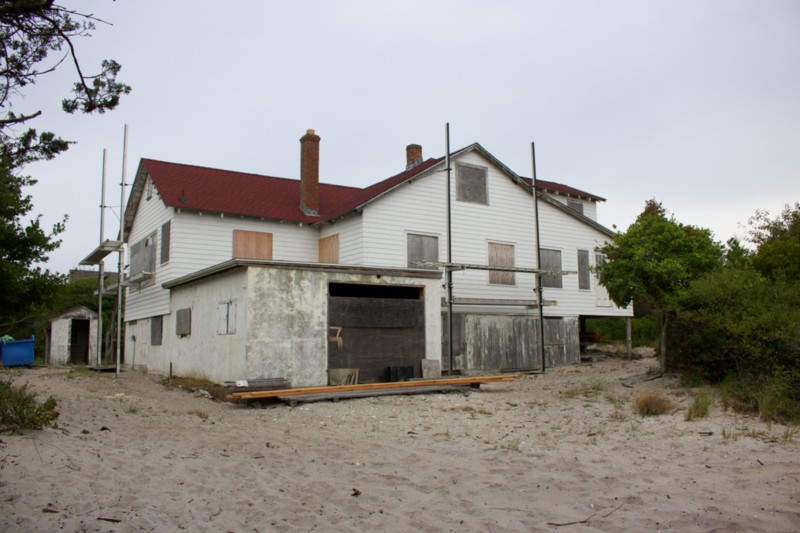Frank Carrington House, Fire Island
Introduction
Text-to-speech Audio
Images
The Carrington House during Frank Carrington's time in the home.

Frank Carrington in front of the Carrington House.

The Carrington House as it stands today.

Backstory and Context
Text-to-speech Audio
Fredrick E. Marquet is believed to have built this now-historic house after he bought the land in 1912. He used it as a summer home till he sold it to Frank Carrington in the late 1920s. Frank Carrington was heavily involved with theatre throughout his life. Carrington helped create the Paper Mill Playhouse and assisted in creating the Arts Project of Cherry Grove, in 1948.
The Carrington House is tucked between Cherry Grove and the Pines of Fire Island. The property consists of the main house, guest house, and small utility shed. This home is best known for previous owner Frank Carrington who contributed to the theatre scene of the local area and also served as one of the centers of the island's LGBT community. The property is also significant for its representation of the early twentieth-century bungalow style and is one of the oldest remaining houses on the island.
The area of Cherry Grove and the Pines began to thrive in the 1920s with renters of homes in the area during the summer. These individuals were of mid to upper-class financial standing for the time, with most of them being homosexual. Homes on the island were rented mostly in the summer, with the relation to gay individuals increasing as time went on. They began to buy homes in the area, and it soon became a comfortable place for gay individuals of the time.
Within the 1950s, the area was home to a small but growing gay community. Around this same time, police began raids on the island in response to complaints and claims of moral degeneracy from some area residents. The raids led to multiple arrests similar to those raids that would be frequent in New York and other communities until the start of the gay rights movement. At the time, these arrests were part of the harassment that led many gay individuals to hide their identity behind a mask they would only take off in safe places such as Carrington's home.
The home’s location between Cherry Grove and the Pines creates a form of privacy and seclusion,
yet also convenience due to its vicinity. This privacy led to many renting the
home from Carrington, most notable of these being Truman Capote. In the late 60s, Carrington began to look for a purchaser of the home. During this time, he stipulated that he wanted the home to be
cared for and kept up with. He sold the home to the United States government in
1969. Though his desires for the home to be preserved was not part of the
contract he reserved his rights to remain on the property and go as he pleased as long as he was alive.
After Carrington’s death in 1975, a park ranger and his family lived in the home until the late 1990s. The property is in current need of repairs and has been sealed to protect the home until repairs can take place.
Sources
2. National Register of Historic Places Registration Form. National Park Service. Accessed March 29, 2019. https://www.nps.gov/nr/feature/places/pdfs/13001057.pdf.
3. Photo of Carrington House. Fire Island Pines Historical Preservation Society. Accessed April 22, 2019. http://www.pineshistory.org/celebrities/the-carrington-estate-est-1912-2/.
4. Photo of Frank Carrington. Fire Island Pines Historical Preservation Society. Accessed April 22, 2019. http://www.pineshistory.org/celebrities/the-carrington-estate-est-1912-2/.
